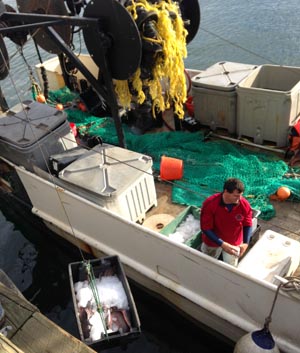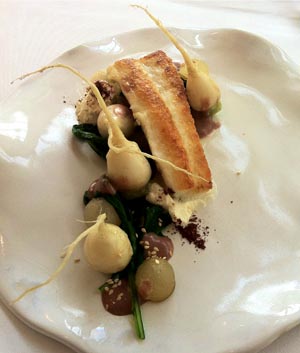

(left) Unloading dogfish at the dock in Boston, MA; (right) Dogfish dish at the Ashby Inn in Paris, VA
One of the most common questions we encounter is, "How do I know what fish is ok to buy?" Polls show that most Americans want sustainable seafood, and over half are willing to pay more for it, yet navigating the waters of eating better fish remains baffling for many of us. To make matters more complicated, sustainability labels are confusing, and fish fraud runs rampant. So how do we do the right thing?
One simple step we can all take is to buy wild domestic seafood. 91 percent of the seafood consumed in the U.S. is imported, and over half of what we catch here is sent overseas. Talk about a broken food chain. With our own traditional fishing communities struggling for better access to the marketplace, it's nonsensical that we eat so much imported fish. In fact, American fisheries are actually the world leader in terms of sustainability. When the Magnuson-Stevens Act was passed in 1976, it became federal law that no U.S. waters could be overfished. Though it has taken time, around the country wild fish stocks are rebuilding, management is improving, and independent fishermen have a better chance at passing their work down to the next generation.
Atlantic Spiny Dogfish is one recent example of an American seafood success story. Unappreciated here in the U.S, no rules were put in place to protect the species, and increased demand for the fish in Europe led to declining stocks. Strict management was implemented, and the fishery was declared rebuilt in 2010, receiving MSC certification in 2012. Dogfish is somewhat of a Cinderella story in the fish world: it's gone from an undervalued species to a sustainable, delicious, affordable option. What is more, it supports the Northeast fishermen who are looking for new fish to catch after recent cuts to the Atlantic cod quota.
In addition to getting patriotic with our fish choices, eating sustainable seafood means broadening our horizons. Too often we stick with the familiar, tried-and-true fish instead of asking, "What's seasonal, fresh, or local?" When we stay open to less familiar seafood, we take the pressure off popular species and create more economic opportunities for traditional fishermen who catch a wide range of delicious wild fish. Of course, the best question you can ask is "Who caught my fish?" If your chef or fishmonger doesn't know, buy from someone who does.
It's time that we start noticing more of our diverse domestic wild fish species, and make fish like Atlantic Dogfish the belle of the ball. Fixing food systems is no easy task, but sometimes answers are right in our own backyard. Let's start supporting our own traditional fishing communities, and looking to our own waters to sustain us.
